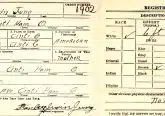Calendar Transitions and Double Dates
We celebrated the beginning of a new year on January 1, 2025. Did you know January wasn’t always the first month of the year? The early Roman calendar consisted of only 304 days divided between 10 months, so the year started in March and ended in December, and the months were divided into Kalends, Nones and Ides.
The history of calendars has ancient roots connected to astronomy and agriculture. The earliest calendars were lunar, based on the moon’s phases, which did not synchronize with the seasons.
THE JULIAN CALENDAR
Aiming for a more accurate system and advised by the astronomer Sosigenes of Alexandria, Julius Caesar created a solar calendar that was implemented in 46 BC. Its fixed year of 12 months consisted of 365.25 days and a leap day every four years.
Solar calendars like his are based on the time it takes the Earth to orbit the sun, but lunisolar calendars, like the Hebrew and Gregorian calendars, align with both the moon’s phases and the solar year.
THE HEBREW CALENDAR
The Hebrew Calendar is lunisolar, with the years counted since the Temple’s destruction, the current year being 5785. Days are measured from sunset to sunset, and the year begins in September or October with the festival of Rosh Hashanah. This calendar determines the appropriate weekly Torah reading and daily psalm readings, as every synagogue around the world reads the same portion of the Torah each week.
THE GREGORIAN CALENDAR
On February 24, 1582, Pope Gregory XIII issued the papal bull “Inter gravissimas,” claiming the Julian calendar wasn’t keeping up with nature’s calendar. He thus refined the Julian calendar mathematically and created a new system that we use now and know as the Gregorian calendar with January 1 as the year’s first day. This calendar is now an international standard for civil use. There are, however, approximately 40 more calendars in use today, such as the Chinese, Hindu, Islamic and Persian.
ECCLESIASTICAL RULES
The ecclesiastical calendars of Christian churches are based on cycles of movable and immovable feasts. Christmas is the principal immovable feast, with its date set at December 25. Easter is the principal moveable feast, and the dates of most other movable feasts are determined in relationship to Easter (e.g., the Ascension and Pentecost). However, Pope Gregory’s papal edict applied only to lands over which the Catholic Church had dominion. Thus, most Protestant countries didn’t adopt the calendar until between 1699 and 1701, and Great Britain, Ireland and the American colonies did not switch until 1752.
THE CALENDAR CHANGE OF 1752
This is one of the most confounding date-related events in history that impacts genealogical researchers—11 calendar days were lost forever! New Year’s day was moved from March 25 (Solemnity of the Annunciation of the Lord) to January 1 to correlate the Annunciation with the Solemnity of the Nativity (Christmas day), which is nine months later. Between this time and 1752, both calendar versions were used in Europe: Julian Old Style (OS) calendar and Gregorian New Style (NS). Great Britain fully adopted the Gregorian calendar and passed the Calendar Act (known as Chesterfield’s Act in American usage).
There was a discrepancy between the calendars of 11 days by the time England and the American colonies adopted the Gregorian calendar. To resolve this, the government ordered that September 2, 1752, be followed by September 14, 1752, adding 11 days to many people’s birth dates— which may or may not be noted on their birth records.
To address the 1752 issue in your genealogy research records, write pre-1752 dates exactly as found, then access an Old Style-New Style Julian converter that accounts for the old New Year Days (free at www.cyndislist.com; search for “calendars and converters”). Enter the Julian date to display a modern Gregorian date. Avoid confusion of “double-dates” by indicating a date as Old Style (OS) or New Style (NS). For example, enter 23 February 1656 OS or 23 February 1657 NS, or use double indication (23 February 1656/7).
NEXT UP: Cousins and Kinfolk. What does it mean to be a second or third cousin removed once or twice?
 Ruthy Trusler is a communication consultant with a passion for genealogy. For over 20 years, she has helped families document their ancestry and write their family legacies.
Ruthy Trusler is a communication consultant with a passion for genealogy. For over 20 years, she has helped families document their ancestry and write their family legacies.
This article appeared in the February 2025 edition of The Catholic Telegraph Magazine. For your complimentary subscription, click here.














